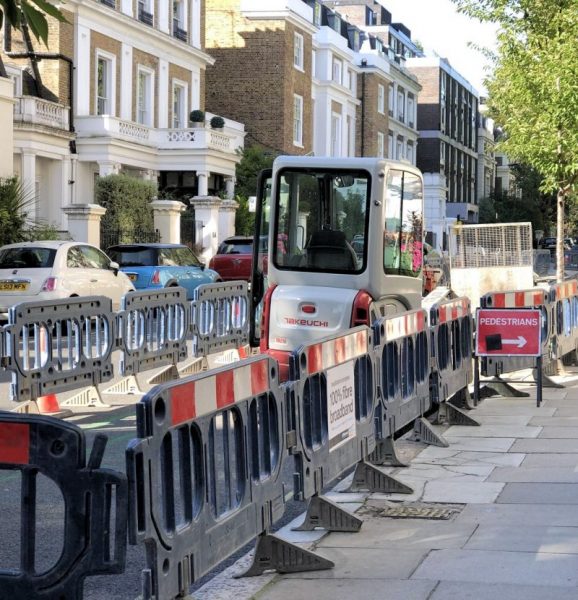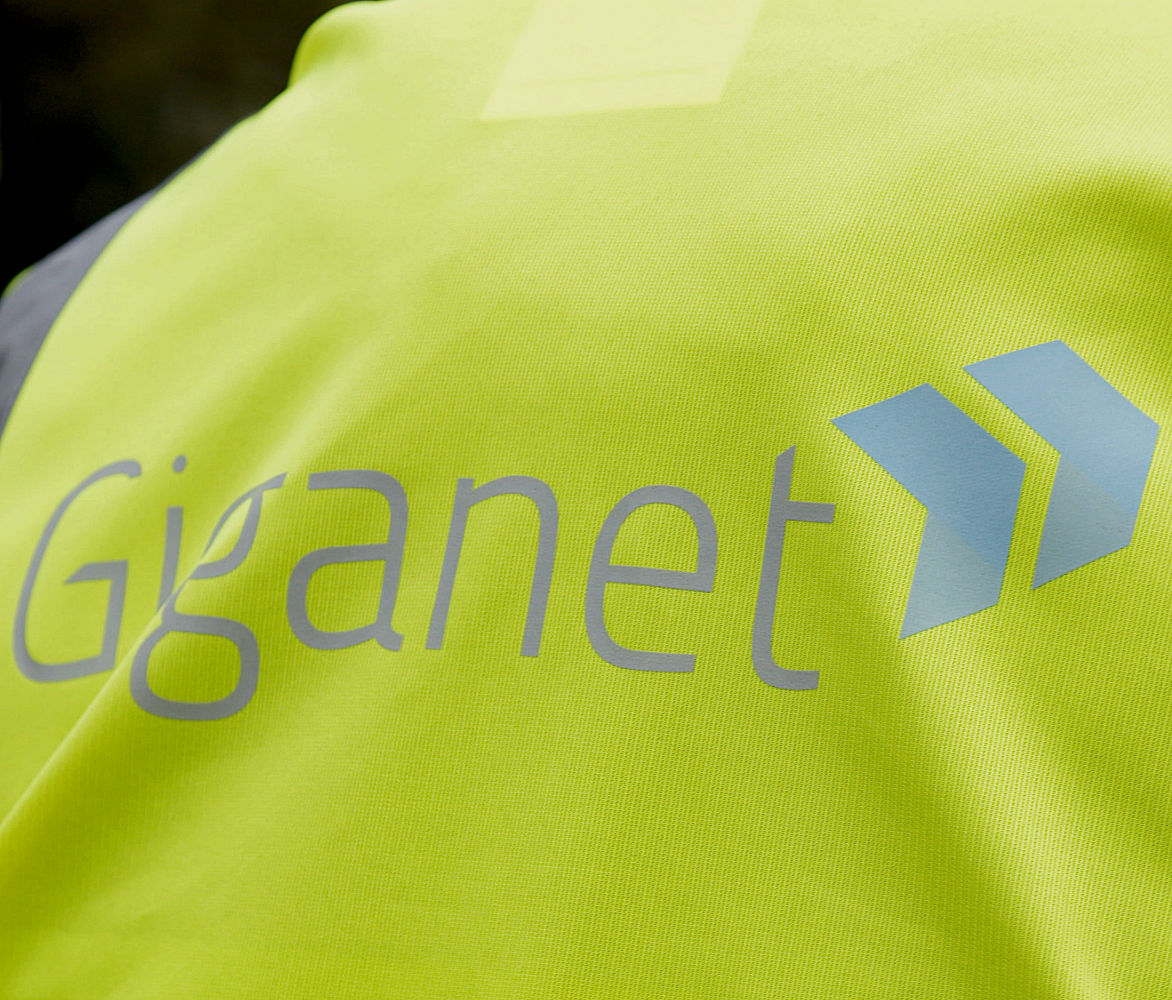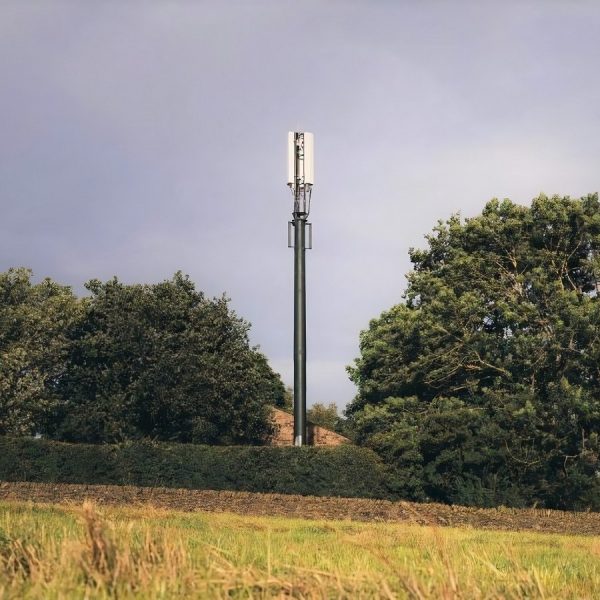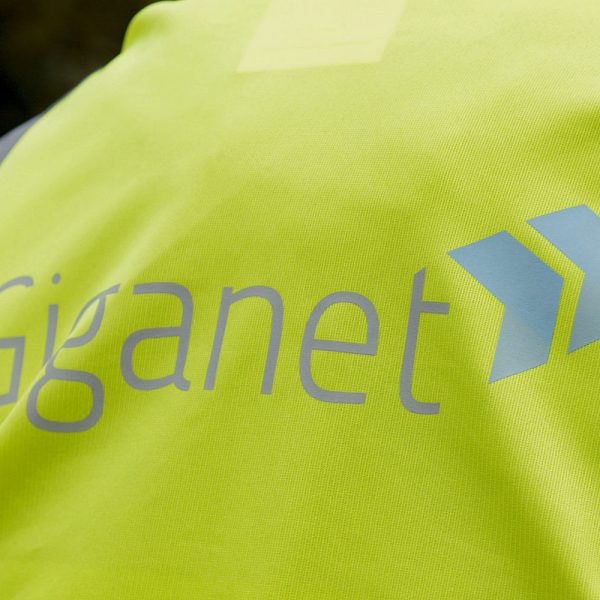Say Hello to the First UK Street with 3 Full Fibre Broadband ISPs

How about this for consumer choice. Some premises along a street in St James’s (Central London) have just become one of the first UK locations to enjoy a choice of three “full fibre” (FTTP) ultrafast broadband networks, including via Hyperoptic, Openreach (BT) and G.Network. But many more will soon crop up.
In dense commercially competitive urban areas it’s quite normal for broadband operators to end up overbuilding each other with rival infrastructure, which is something that has occurred in the past between Openreach (BT) and UK cable operator Virgin Media using different infrastructure (hybrid fibre, copper etc.).
Now the increasingly rapid growth of competition in the new market for gigabit-capable Fibre-to-the-Premises (FTTP) infrastructure is threatening to do the same, although until recently we mostly only saw overbuild taking place between two rival full fibre operators. Inevitably this was always going to change, particularly with alternative networks like Cityfibre (Vodafone, TalkTalk), Hyperoptic, G.Network and others joining the fray. Not to mention Virgin Media’s expansion into FTTP.
Research group Point Topic is now confirming that a three-way overbuild has just taken place along a street in the St James’s district of Central London (City of Westminster). The group claims that this is the first three-way full fibre street in the UK, but with so many active deployments it’s hard to be certain (e.g. there are a few other areas that may technically already be at or nearing this point).
“We expect suppliers to focus on areas where they can get the best return and where they can also get a cooperative planning environment, with Westminster Council as one of the leading exponents of facilitating wayleaves and helping their residents and businesses (see their broadband voucher success) get more bandwidth,” said Point Topic.
Snap Summary of Related Full Fibre Providers
Openreach
Currently covers 2.156 million premises and aiming for 4 million by March 2021, which is followed by an ambition to achieve 15 million by around 2025.
Hyperoptic
Currently covers over 400,000 premises and aiming for 2 million premises by the end of 2021, then an aspiration for 5 million by the end of 2024.
Currently covers around 75,000 premises on more than 200 London streets and expected to reach 120,000 premises at some point in 2020.
The Government’s 2018 Future Telecoms Infrastructure Review claimed that “at least a third (with the potential to be substantially higher) of UK premises are likely to be able to support three or more competing gigabit-capable networks,” although not everybody agrees with that.
Some altnet ISPs (e.g. Cityfibre, Hyperoptic, Gigaclear and TalkTalk) have previously raised concerns about the risk of major players like Openreach using their weight to overbuild in an anti-competitive way (here). Such networks are very expensive to build and it may thus become harder for providers to gain a return on their investment, or even to attract new funding, if lots of networks overbuild.
On the other hand aggressive competition is to be expected (natural) in dense urban areas, which invariably results in winners and losers. Likewise having access to so many full fibre networks is a potentially huge benefit to consumers who will find themselves with a much wider choice of broadband infrastructure; although this may also cause some consumer confusion over availability.
On the flip side local residents and business may find themselves in an awkward position with multiple different sets of disruptive and noisy street works occurring one after the other in the same area. Having your driveway blocked for a few days or longer by such work is one thing, but having that occur several times over, in a short-ish space of time, risks generating a lot of anger.
At present though many networks are trying to avoid one another but it is inevitable that we’ll see more overbuild and a rise in multiple full fibre networks crossing the same areas. Perhaps one day we may even see four FTTP providers in the same spot.
UPDATE 2:18pm
Just as a small side note, but Openreach’s FTTP build in the area is not a commercial one and has instead been co-funded with the Grosvenor Estates (to provide open wholesale access).
Mark is a professional technology writer, IT consultant and computer engineer from Dorset (England), he also founded ISPreview in 1999 and enjoys analysing the latest telecoms and broadband developments. Find me on X (Twitter), Mastodon, Facebook and Linkedin.
« First Customers Live on KCOM’s New £100m FTTP Expansion
Ofcom Appoint Dame Melanie Dawes as CEO, Replaces Chairman »
Latest UK ISP News
- FTTP (5515)
- BT (3514)
- Politics (2537)
- Openreach (2297)
- Business (2262)
- Building Digital UK (2244)
- FTTC (2043)
- Mobile Broadband (1973)
- Statistics (1788)
- 4G (1664)
- Virgin Media (1619)
- Ofcom Regulation (1461)
- Fibre Optic (1395)
- Wireless Internet (1389)
- FTTH (1381)





























































“Central London” …
Says it all really …
It was hardly going to be a hamlet of 3 houses and a pub, was it Ray?
London is, by a mile, the largest city in the UK. More than 1 in 10 of the entire population live there. It was the most likely course of events.
If it makes you feel any better there are other places where there are two full-fibre operators in direct competition and some where there are two full-fibre operators plus Virgin Media.
There are also some rural areas were full fibre ISPs / networks are in overbuild (e.g. B4RN and Openreach). I believe Ecom and Gigaclear may also have the odd area of close conflict.
Quite a few place were GC and OR abut deep rural. That may turn into some overbuild
@Ray Woodward “Says it all really”, really says it all …
I live in central london (only about a 10minute walk from St James Street mentioned in the post) and still stuck on an ADSL2+ EO line. I do get decent speeds, syncing around 19mbps but alot of Westminster is lacking any fast broadband.
I did have G.Network laying fibre on my street around September time in 2019 but not ready to order yet.
My work place is on St James – Regent Street side, no G.Network and don’t even have plan to laying cable there. Hyperoptic is available but leased line only starting from £200 ex vat a month.
Adsl can offer 17 mb download which is not bad but the upload speed is not good enough nowadays.
@SamHI, @CYW
If that is your location, noting property prices in that area I wonder why you/your business can’t afford to pay for the provision of FoD or a similar service if the bandwidth available over ADSL isn’t sufficient?
If you’re still using ADSL with the advent of 4G/5G you need your head examined.
@New_Londoner
This is long time issue in Westminster when ISP’s mainly focus leased line services.
I know the price is small when you compared to the rent in Westminster but do you think getting Hyperoptic 150/150 leased line – £200 ex vat or BT 100/100 line (not 100% leased line) – £220 ex vat is justify for a small office with just 4 people? I can’t justify the cost and would say this is a rip off.
Currently using Vodafone 5G GigaCube, 5G signal is weak but stable on 4G – 100Mbps down/15Mbps up for £41.40 a month.
That photo is Kensington not St James…..can’t remember the name of the street but close to the Boltons.
As others have said Central London has a lot of EO lines going from EO -> FTTP expect high take up rates. Hence commercial prioritisation of those areas. You have build density and demand density……
I’m aware, pictures aren’t always specific to the location mentioned in an article since they rarely carry that level of detail in the first place (we use them more in a generic illustrative fashion). However the image is of a related G.Network build.
Supposed to be supprised london getting even more improved services shocker..
Some still have none..
The problem isn’t that commercial companies are only targetting profitable areas (that’s to be expected), it is that the intervention that should be provided by the BDUK bodies to prevent areas being excluded isn’t really working. It is too little, too slow, and isn’t keeping pace with the changing broadband environment.
I’m not sure I’d be that negative.
Boris has announced a £5bn pot to build the hardest 20%
There is a lot of good commercial work going on that spans urban and rural and EO.
Yes, it is a patchwork quilt ATM but things are getting better for a lot of people who suffered. I can’t really criticise the speed of build now as we are at a stage where it is resource, not cash, constrained on a national level. A lot of operators would build faster if they could.
BDUK is working very well in some areas where they are rapidly through BDUK stage 3 rollouts, while in others its been a complete mess. There really should have been some mechanism put in for the BDUK process where intervention could have been carried out on the councils who are failing at BDUK.
In the Fastershire area it isn’t working well for a lot of people. And I don’t expect that to change anytime soon. From their “Fastershire Broadband Strategy 2019-2022”:
“The National Broadband Scheme 2016 has come to the end of its life and there can be no further supply side procurements until BDUK negotiate a new state aid regime which is unlikely to be in place until well into 2021.”
…
“It is likely that it will be 2023 until their Outside In plan is delivering in earnest.”
@AnotherTim – Hampshire is no better. When I complained to Hampshire broadband project the response I got was: You’ve got FTTC of up to 37Mbps so you must be ok, go away. I’m only getting 20Mbps sync speeds and dropping every year. I recently got guarantied 15Mbps by BT for a new contract so no help there. I live on an urban street in a small town.
The danger as I see it is that with USO coming into effect and numerous commercial FTTP rollouts in many urban areas it is very easy for politicians to see it as job done, broadband problems solved.
However, even Fastershire’s latest strategy document expresses the opinion that the government’s Outside In strategy won’t help those that don’t have superfast broadband, so the job is actually far from done.
I supposed they have to go down some streets so might as well cable them up anyway, but surely the ROI and expected take-up rates plummet in these scenarios?
I also assume most of these companies will eventually merge in one way or another.
Correct. More the potential market is shared the lower the ROI and the more under utilised network. We know who pays for that.
The more it occurs the more it will put OR off investing in those particular streets which would be OK but there is no obligation on the Altnets to provide 100% coverage.
London.
Shocking.
Good for them! I’m sure those 40 or so households with very wealthy owners will be pleased. Wake me up though when it spreads to everywhere else in the country, I’m sure it won’t take more then 20 years plus.. I’d like to have a choice of one…
What if councils were to forbid OR and altnets from overbuilding in certain crowded places? If this were done would it force collaboration by, say, duct sharing?
Current policy is market driven with competing CPs. Altnets already have access rights to OR duct (with issues). No proposals to open up VM duct (now over 50% of premises). No mandatory open wholesale ISP availability requirement.
Councils can insist on NRSWA provisions and reinstatement but cannot prevent utility activity.
Some serious green eyed monster syndrome in this comments thread. Not surprising I guess.
As stated about a third of the UK should be able to sustain three competing operators. It’s not really the fault of the people living in that third that a fair amount of people will require taxpayer funding to sustain one operator.
You’re right, but lets not forget that a large number of those who benefitted from tax payers money spent on BDUK, are also now likely to be more commercially viable for FTTP.
Yes, many people that have benefited from tax-payer funded superfast broadband are now being seen as viable for commercial FTTP. Meanwhile many tax-payers are left with no prospect of superfast broadband for years.
I think there really should be a concerted effort to tackle that. And I don’t believe USO or RGC will do it.
AnotherTim
I agree.
Surely it would be prudent to avoid having multiple Fibre lines to the same place, and instead focus all resources to get the WHOLE COUNTRY having fibre lines to all premises (homes and businesses).
It would be better if the government nominally owned all the infrastructure that connects exchanges/nodes/satellite links/whatever to people’s houses. And at that point, either one operator (like Network Rail/UK Powernetworks) either owned by the government, or with a significant taxpayer stake, then builds Fibre to replace all the copper.
That way every single home would have the copper line replaced with a Fibre one. This should be a RIGHT and not an option. Anyone willing to pay for a telephone line should get a Fibre line FULL STOP.
If necessary, then the government should own the “National Fibre System” and then tender out the contracts to any private bidder (Openreach, CityFibre, Google, whoever) to convert parts of the National network to Fibre in the same way that contracts are tendered out to build airports.
Retail ISPs can then offer services nationwide and pay rents to the single network on a contract whereby the National System is obligated to maintain it. It’s the same as when a power cut happens, UK Powernetworks deals with the fault (hopefully quickly).
This entire mess then won’t happen where the vast majority of the country have no fibre, the fraction that do are beholden to one operator, and the prices are simply ridiculous no matter what is available to you.
As bad as the mobile operators are, at least there is competition and a degree of fairness versus the various regional, or business monopolies and lack of progress in FTTP.
There should be:
1. A law that sets a fast target (2025) for ALL existing copper lines to be replaced by Fibre
2. A law that sets a global benchmark set target to put us on par with the likes of South Korea in terms of speeds within a period of no more than 10 years.
3. A law that prohibits the use of the term “Fibre” in marketing any broadband product UNLESS it is FTTP/FTTH. No FTTC product should be labelled as Fibre.
4. A law that sets the minimum “acceptable” speeds provided by ISPs of 50 Mbps download for households and any speed below that gets a significant discount on the advertised price.
5. A law that mandates a symmetrical nationwide FTTP network within no more than 10 years for the entire country, with the freedom of consumer choice to choose speed at ANY property (i.e. properties should not be restricted to 330 download, but can choose the speed they want and ALL ISPs have access to the same network).
@JU – there not the resources to achieve a 2015 date, unless you can show.
‘First uk street with 3 full fiber ISPs’ … Hmm well, we have Truespeed, Gigaclear and BT offering full fibre here so not sure on that, certainly isnt the first.
There are also a few with Community Fibre, Openreach and Hyperoptic that may qualify too. As per the article, we’re sceptical about the “first” claim from Point Topic but as we don’t know precisely when all of the builds took place then it’s hard to say. Either way a few contenders are cropping up. What’s the name of your place?
I laughed when I read the headline! But I knew this was coming, but wasn’t expecting it to come this soon! 😀
Once you pass wayleave agreement then it is very much possible to see multiple FTTP providers building on the same premises eventually. The reason I say this, is because I was in contact with Hyperoptic, G.Network and Community Fibre via email a couple of years ago and all 3 were interested to speak to the Housing Estate Manager of my block but were denied permission.
Even Openreach initially were on course for FTTP but had to revert back to FTTC on my EO Line.
I finally have FTTC as of last week for the first time and achieving top 80/20 Mbps speed test here in Central London with TalkTalk, so I won’t moan too much. 🙂
It is interesting to see with a consumer choice of FTTP providers which of them performs the best now! These residents are very lucky!
However, I still don’t believe that this is the right stage now to have multiple FTTP overbuilds.
To be expected in high density areas, theyre fighting for market share as well as the fastest ROI, much as it will annoy others who are being left two generations of tech behind. If theres public monies being spent that would be a different matter.
I’m shocked it’s not somewhere in the middle of nowhere
Meanwhile the fibre not spots continue nearly a decade after FTTC deployments literally yards away from me and despite openreach now saying their FTTP build is complete in the area
No doubt someone, maybe even someone from openreach will select three ‘random’ addresses to try and claim otherwise
More likely they could just point out that the Openreach site specifically says that build complete doesn’t mean every property, if you are the guy I think you are who claimed there was no FTTP in Leeds.
Alternative supplies could connect you, if they wanted to.
Meanwhile we cannot even get FTTC and suffer from <3Mbps on a new housing estate in a town in the North (not exactly rural). Demonstrates the London-centric thinking of government.
@Michael
This is not one for government, this reflects the commercial decisions of three private sector organisations seeking to make a profit for their shareholders.
Or it demonstrates that the developer was indifferent to delivering you guys good broadband.
The three operators on this street all spent their own money.
This decision would have been made by your developer, they chose the network for the estate during the build stage.
There are various set up’s on offer, from different network providers offering different CP’s, some developers even have their own and will not let anyone else access (Persimmon come to mind).
Surely it would be prudent to avoid having multiple Fibre lines to the same place, and instead focus all resources to get the WHOLE COUNTRY having fibre lines to all premises (homes and businesses).
It would be better if the government nominally owned all the infrastructure that connects exchanges/nodes/satellite links/whatever to people’s houses. And at that point, either one operator (like Network Rail/UK Powernetworks) either owned by the government, or with a significant taxpayer stake, then builds Fibre to replace all the copper.
That way every single home would have the copper line replaced with a Fibre one. This should be a RIGHT and not an option. Anyone willing to pay for a telephone line should get a Fibre line FULL STOP.
If necessary, then the government should own the “National Fibre System” and then tender out the contracts to any private bidder (Openreach, CityFibre, Google, whoever) to convert parts of the National network to Fibre in the same way that contracts are tendered out to build airports.
Retail ISPs can then offer services nationwide and pay rents to the single network on a contract whereby the National System is obligated to maintain it. It’s the same as when a power cut happens, UK Powernetworks deals with the fault (hopefully quickly).
This entire mess then won’t happen where the vast majority of the country have no fibre, the fraction that do are beholden to one operator, and the prices are simply ridiculous no matter what is available to you.
As bad as the mobile operators are, at least there is competition and a degree of fairness versus the various regional, or business monopolies and lack of progress in FTTP.
There should be:
1. A law that sets a fast target (2025) for ALL existing copper lines to be replaced by Fibre
2. A law that sets a global benchmark set target to put us on par with the likes of South Korea in terms of speeds within a period of no more than 10 years.
3. A law that prohibits the use of the term “Fibre” in marketing any broadband product UNLESS it is FTTP/FTTH. No FTTC product should be labelled as Fibre.
4. A law that sets the minimum “acceptable” speeds provided by ISPs of 50 Mbps download for households and any speed below that gets a significant discount on the advertised price.
5. A law that mandates a symmetrical nationwide FTTP network within no more than 10 years for the entire country, with the freedom of consumer choice to choose speed at ANY property (i.e. properties should not be restricted to 330 download, but can choose the speed they want and ALL ISPs have access to the same network).
Cool. You are paying the taxes to cover the bills for this, right John?
As a general guide your average working age household needs to be earning not far off £40k before taxes to actually contribute to the national budget.
I hope to be as rich as you in being able to pay so much tax that I can so freely call for billions of taxpayers’ money to be spent controlling when and where networks already being built majority commercially are to be constructed.
Laws for who to provide?
CarlT
We already all pay taxes for things. The only reason this doesn’t happen in this country is because there is no political will. Instead of wasting tax payer’s money which went to the Local Councils to fund Openreach’s Fibre delivery, we could have done this instead and still can. The entire project funds itself though the tendering of upgrading the national network to the private sector on an explicit legal compulsion to upgrade the entire nation – EVERY house that has a copper line. Retail ISPs can then offer private products ANYWHERE on the national network, the same way the electricity grid works.
Investing in a national Fibre network is well worth it, since it pays off on the long term and benefits EVERY house and business across the country. It should be mandatory for the whole copper network to be replaced with a Fibre network. And it should be illegal to market FTTC as “Fibre broadband”. If it isn’t fibre to the premises, then it isn’t fibre full stop.
The taxpayer or government only needs to break off Openreach from any link to BT, and then if you bothered to read my post, can raise money by tendering out development of the national fibre service (i.e. the network) to various private entities. That can include CityFibre, Google, any new players from anywhere – i.e. PRIVATE enterprise. What is pointless is having overbuild with multiple fibre lines (which doesn’t benefit anyone anymore than having one piece of fibre in that locality), and having the rest of the country without a single bit of fibre. Fibre should be a RIGHT in this day and age and if the country values being at the top of its game for economic competitiveness and standards of living versus parts of continental Europe and East Asia which have cheaper fibre products of far higher speeds available to households, then we should get on with this NOW. It would be simple to operate one national system, with the private sector entering contracts with the government on competitive bids to invest and hold a stake in each part. If the government does it, then it is accountable to the taxpayer, versus Openreach who are accountable to no one, but short term shareholders and no visionary management.
The Universal Service Obligation of 10mbps is laughably abysmal. For £45 a month you can get 1Gbps FTTP in Singapore. And fibre broadband is cheaper in rural Portugal, Spain and France than it is in the villages of the UK on the Openreach network, and more reliable too. There is no competition because the entire setup in the UK fibre/telephone sector is just an oligopoly. If you want to applaud mediocrity then you’re free to. You can’t force others here to.
@JU – what would you do with the Virgin Media network?
Deregulation brought fibre to Portugal, Spain and France, not government overreach. Spain especially benefitted as its equivalent of BT was given regulatory breaks, not compelled by government.
Portugal likewise is being permitted to switch off copper, incentivising private investment.
Singapore is a citystate in case you hadn’t noticed. It is also an authoritarian one party state.
The speeds drop rapidly when outside of the state and are wildly variable. Something unlikely to be tolerated here.
A bunch of things can be better. I very much disagree that taxpayer funding for what you think you should be entitled to is the way to go though. The private sector is investing and should be allowed to invest before the taxpayer is tapped for resources.
Make tenders unattractive and companies simply won’t bid. Then what? The whole point is you want to tell companies how to spend their money. If the investment is viable they’ll do it anyway without compulsion. If it isn’t viable they’ll want subsidy.
@The Facts
1. Government passes law stating that all copper lines (or any new telephone line) must be fibre. Deadline is let’s say 3 years (i.e. March 2023, or else the network operator will have to pay the government a fine of £10,000 per copper customer per day).
2. Openreach is split off from BT by law. I can’t see any voter rushing to BT’s defence. Do what the United States did with Standard Oil to break up a MONOPOLY. The substituent parts remain PRIVATE.
3. Openreach remains a private company and gets to keep its fibre building assets, but no the physical network.
4. The original Openreach network becomes part of a new entity known as British Fibre (or call it The Facts Fibre/Fibre Britannia/Future Fibre/Royal Fibre whatever you want), modelled on Network Rail, or UKPowernetworks. This entity has a 30% taxpayer stake with a veto over any takeover of the entity. The remaining stake (70%) is split in proportion to money invested already by Openreach (i.e. the private Openreach company is given shares which they can sell) and any other company willing to voluntarily hand over its fibre network to British Fibre (e.g. Hyperoptic, CityFibre, B4RN, Virgin Media etc) with the balance apportioned off onto a listing on the London Stock Exchange. The company will be publicly listed.
5. British/Royal Fibre has its own board and freedom of operations as a publicly listed company on the LSE. Its only limitation is British law that states that the UK telecoms network (which includes copper lines at present) must be FULL fibre to the property (FTTP/FTTH) by 2023. An additional law can be passed to require the network to be Gigabit capable by 2025 and future proofed (e.g. benchmarked against South Korea, Japan etc) by 2030.
6. Royal Fibre will own and maintain the network and have to tender out the development of its infrastructure in a FREE MARKET. Any company – Openreach, CityFibre, Hyperoptic, B4RN, Google Fibre, Entrepreneur – can bid to win contracts for each region/part of the network – and completes the build work according to a contract. The companies are merely like a construction company tasked with building a building/stadium.
7. All ISP’s will get full access to the central national network maintained by Royal Fibre. Royal Fibre is not beholden to any single ISP. An ISP will pay rental rates to Royal Fibre and the free market will keep prices at reasonable levels. If necessary the government can implement regulations (if there are any) similar to the mobile telecoms market to avoid any ISP from buying shares/being able to influence British Fibre.
That way you will not get overbuilds and underbuilds. You only need ONE fibre line going everywhere and a fibre line that works. I don’t see the electricity companies building 10 electricity lines to the same property to offer their services whilst nearby properties have zero electricity.
Only when ALL properties are full fibre by 2025, will Royal Fibre by law be allowed to sell off parts of the National Network, or other companies may start building new networks. Please note any company (e.g. CityFibre, VM etc) who chooses not to opt in, can keep their existing network, but not build a new one until post 2025. They may however, bid and win contracts to build and own shares of Royal Fibre.
@Carl T
Firstly, it is nonsensical to call Singapore a one party authoritarian state. Utter nonsense. Singapore is a democracy with full free and fair elections. Just because people vote in a party consecutively (with close to 60-70% of the vote despite the First past the post system), doesn’t mean it isn’t a democracy. In Singapore, unlike nearly all other democracies, governments actually do what they promise and deliver instead of cheap gimmicks, electioneering and auctions of non existent resources. Ever notice how at each of our elections, there are suddenly miraculous promises of new train lines and full fibre which are swiftly forgotten minutes after the result is declared.
If you read my comment above, I am not advocating nationalisation. Instead competition laws, breakup of monopolies (similar to Standard Oil’s disintegration by the US into several private entities), and to ensure at least everyone gets fibre before we have multiple overbuilds.
ANYONE would be allowed to compete to win tenders to build. If subsidies are required to start, then so be it. The same has worked for the Wind Power industry in the UK. Started off with subsidies which are now not needed as it’s fully profitable.
Without a government requirement to get things done, nothing will happen. EVERY property should have fibre period. Like climate change laws, once laws are in place, it become compulsory to do things. At that point, companies can still make a profit under the new requirements/laws.
The best thing would be during the temporary relocation of Parliament during the renovation of the Palace of Westminster, instead of basing them in London, base them in a rotating location in the most rural locations across the UK every few months. When they have to live and work with unusable broadband based on prevailing local speeds at these locations, you will suddenly find money appearing from nowhere to get things done when it affects the “servants of the people”.
And who eventually picks up the bill for the shoddy workmanship of the true final re-instatement works, yes the general taxpayer through there council tax these companies should be made to re-instate the full width of the the area they are digging or guarantee there work. I have just watched a band of cowboys making a mess of the local authoritys footpaths and highways installing virgin fttp in bishop auckland county durham.This firm will not be in existence in 5 years time when the disaster of there re-instatements come to life so will poor old dcc have any chance of getting money from Richard Branson. I think not
Fantastic idea, if you want to make the groundwork so expensive that fibre deployment isn’t viable.
The reinstatement guarantee runs for 2 years after which point the taxpayer is responsible for maintenance.
That’s the law.
I live in a council block on the very edge of the City of Westminster and I have a choice of 0 fibre broadband ISP’s while the other blocks next to mine which were demolished and replaced with private flats have had fibre since day one. I’m unable to get Virgin Media because their equipment was damaged during the redevelopment and no BT line because the council cut the cable to the socket redecorating before I moved in and I see little point in paying £120 for Openreach to fix the Council’s wrongdoing, just to be connected to a network that is pretty much obsolete. Hyperoptic have been eyeing up my block for ages whilst Community Fibre have been trying to fit fibre for almost a year but can’t because whilst Westminster have said they’ll grant wayleave they don’t seem interested in following through with it. I have a number of disabilities and I’m pretty reliant on the internet to manage my affairs, yet I’m stuck with a 4G router on three that gets about 15Mbit/s on a good day. There’s 50 other flats in my block, most of whom are eager to get fibre and all of whom it would greatly benefit and it’s absolutely obscene knowing that whilst the richest people in the City of Westminster now have the choice of 3 fibre providers, ordinary people who actually live and work here are expected to go without for the foreseeable future.
You’re misinformed.
If the line is cut before where the master socket is meant to be then you won’t get a £120 charge from OpenReach.
Before the master socket it belongs to them. It’s their responsibility.
@John
I’m pretty sure that Openreach would charge for something that was obviously damaged by the occupant or landlord because it is their property.
OpenReach won’t charge a council tenant to repair damage before the master socket done by a previous tenant.
Did you order from Virgin Media and was refused service? I’d be most surprised if this happened as VM is quite capable of repairing their equipment.